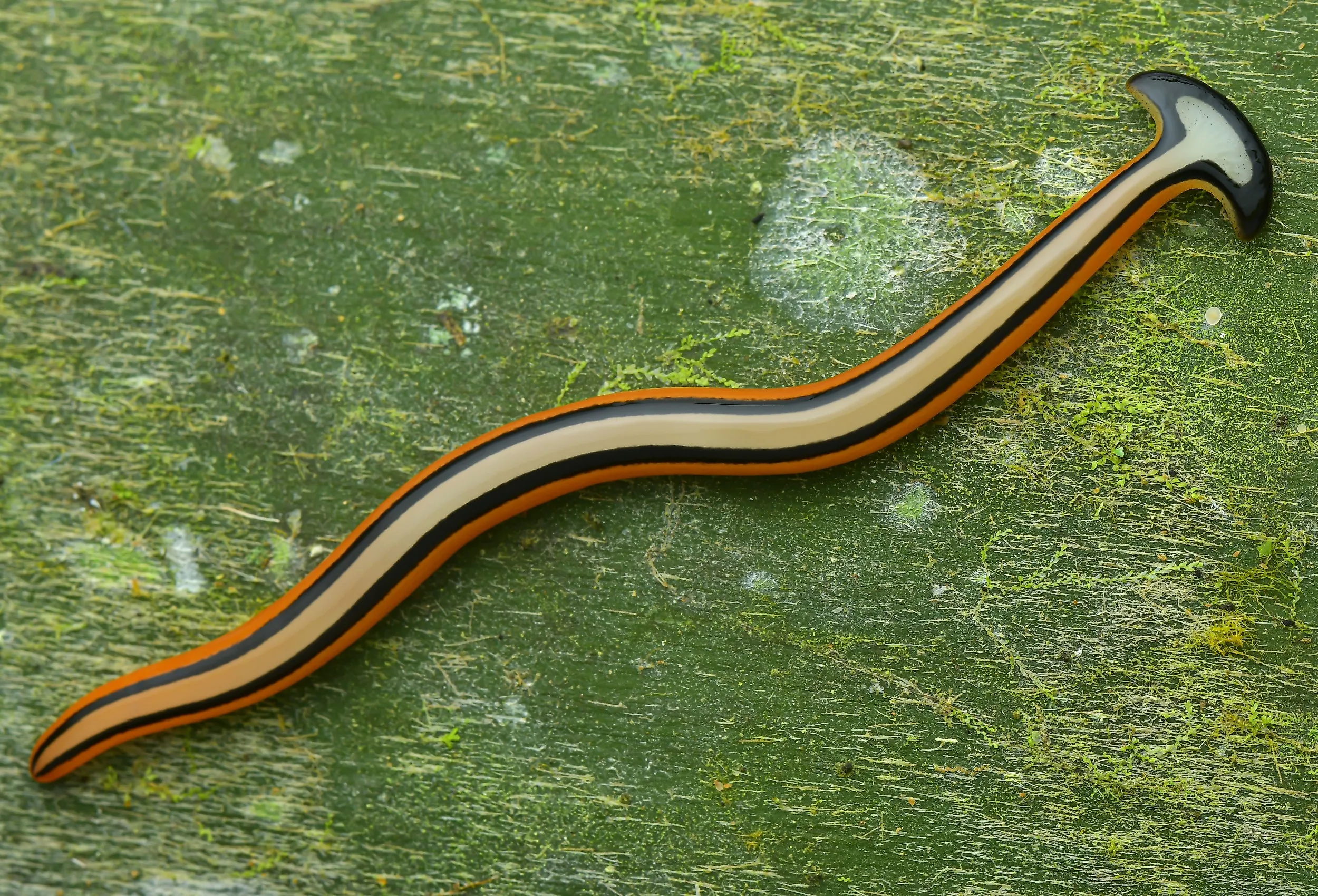
The 10 Deadliest Animals in Arkansas
Arkansas is the 25th US state, sharing borders with Missouri, Tennessee, Mississippi, Louisiana, Texas, and Oklahoma. The state is divided into five regions that encompass unique landscapes—the Ozark Mountains, the Arkansas River Valley, the Ouachita Mountains, the West Gulf Coastal Plains, and the Mississippi Alluvial Plains. Arkansas is known as the “Natural State” because of its stunning landscapes, from its beautiful lakes to its diverse wildlife.
Thanks to its topography and temperate climate, the Natural State hosts a diverse collection of animal and plant species. Timid and adorable-looking animals like the mockingbird, cricket frogs, and white-tailed deer call Arkansas home, but the 25th US state has other residents that have a more sinister reputation. Several wildlife species are considered dangerous animals in Arkansas, from living within dark corners of a home to thriving in the remote wilderness.
Hammerhead Worms
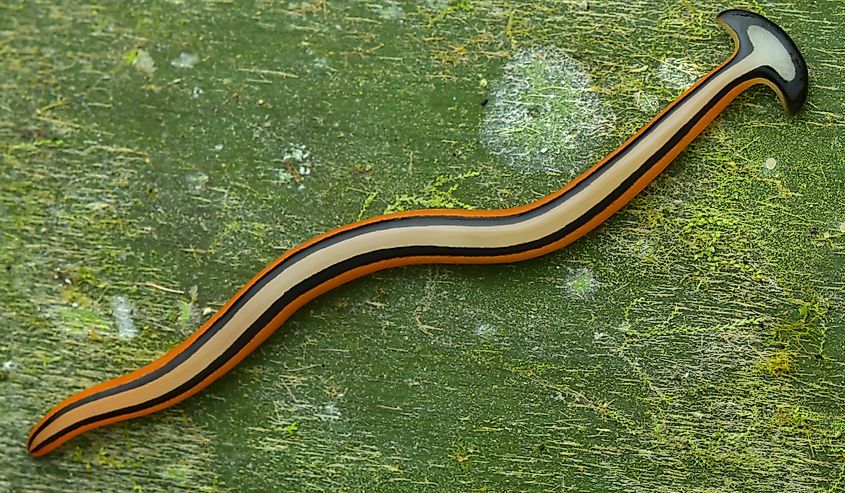
The hammerhead worm (Bipalium kewense) is also known as a shovel-headed garden worm. Native to Southeast Asia, this peculiar worm species was first introduced to the US in 1891, possibly through soil transportation in the horticultural industry. Hammerhead worms are found in the natural habitats of some states like Florida, Louisiana, southern California, Georgia, and Texas. They have also been present across Arkansas for over a decade. These worms prefer warm climates with moist soils, including yards and greenhouses. Hammerhead worms are land planarians with a soft, flattened body that range in length from 3 to 50 cm. Considered an invasive species, they prey on earthworms and may threaten their population.
Hammerhead worms may not be the most dangerous animal in Arkansas, but they secrete a toxin called tetrodotoxin that may cause a rash if it comes into contact with skin, mouth, or eyes. Reportedly, exposure to tetrodotoxin may also cause vomiting, abdominal pain, body numbness, or headaches. Pets may get sick if they encounter or eat the toxin from these worms. A hammerhead worm will only regenerate into new worms if the worm is sliced into pieces and, as a result, will not die. These carnivorous and potentially dangerous worms in Arkansas should be handled with gloves. They can be killed individually by placing them in a freezer or a container.
Black Widow Spiders
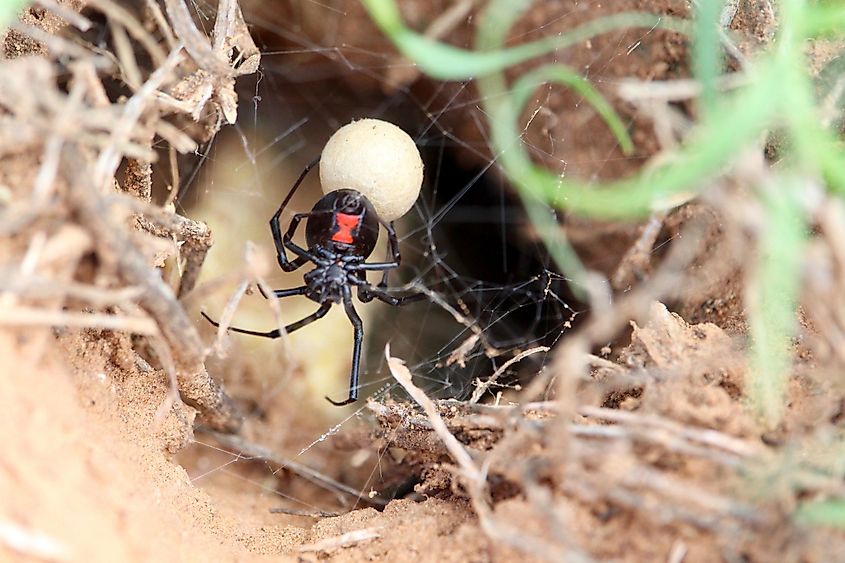
At least two species of black widow spiders are found across Arkansas, though the most common is the southern black widow (Latrodectus mactans). Female black widow spiders are recognized for their red or orange hourglass markings against their jet-black bodies. These spiders usually build their silk webs amongst leaf litter within the grounds of deciduous forests, in mammal burrows, or under rocks, logs, and piles of rubble. They prefer dark corners inside garages, cellars, basements, or sheds in indoor spaces.
The venom of a black widow spider is 15 times more potent than the venom of a prairie rattlesnake! Luckily, a single bite from this spider carries a very small amount of venom. Black widows will only bite those who disturb their webs or when they are trapped in clothing. Female black widows are also shy, non-aggressive, and nocturnal, preferring to stay within the confines of their web.
Brown Recluse Spiders
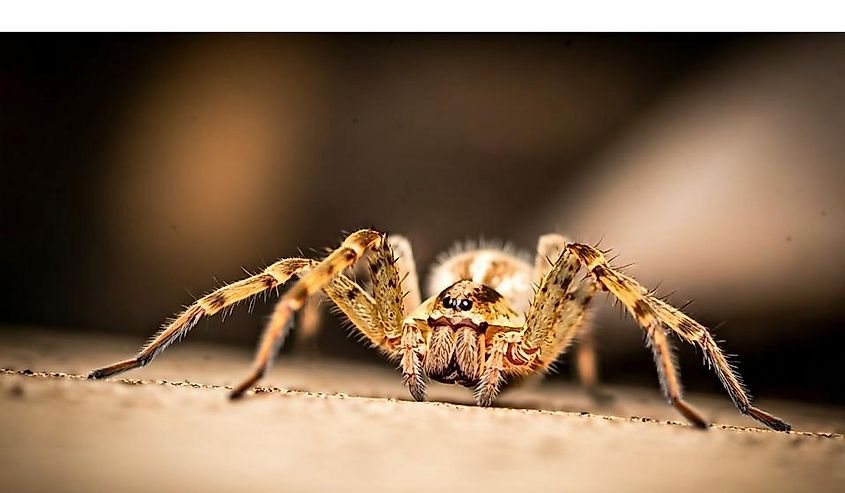
The brown recluse (Loxosceles reclusa) is a soft-bodied spider that resembles several fiddle back, violin, or brown spiders in the US. They vary in color, from a dark, dull grey-brown to a yellow-brown hue. These spiders are primarily present in Midwestern or Southern US states but have also been found in the Middle Atlantic states. Brown recluse spiders can live in rural and urban environments, from thriving inside clothing folds and cellars to living under rocks or beneath rock ledges.
Both female and male brown recluse spiders can inject a venomous bite onto their victim, but will only resort to it when it is being disturbed or crushed. Otherwise, these spiders are not aggressive and prefer to retreat from threats. Common bite areas occur around the hands and arms or when they roll over in bed.
Venomous spider bites, like those from the brown recluse or black widow, can be prevented by reducing the chance of encountering these spiders. Inspect clothing that has been unused and sitting inside a storage area for a long time, and shake it out before wearing it. Clean storage areas regularly and carefully. Insecticides may also be applied to spaces that these venomous spiders frequent, including storage closets or room corners.
If you have been bitten by a venomous spider, like the brown recluse or the black widow, clean the bite area with soap and water and apply a cloth with ice (or dampened from cool water) to the area. If the bite occurred on the arm or leg, a snug bandage can be wrapped around the appendage to slow the spread of the spider’s venom. Medical attention should be sought immediately or as soon as possible.
Eastern Copperhead Snakes
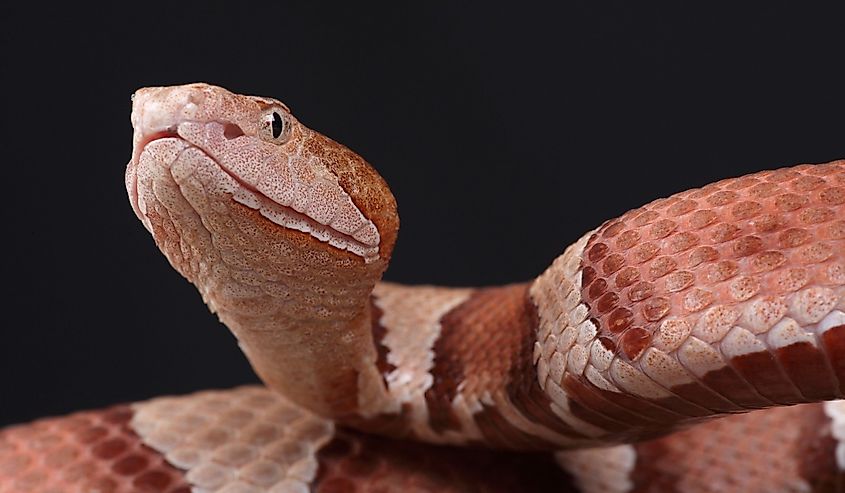
Out of 39 snake types in Arkansas, 6 of them are venomous, including the northern cottonmouth, the western diamondback rattlesnake, the timber rattlesnake, the western pygmy rattlesnake, the Texas coral snake, and the eastern copperhead (Agkistrodon contortrix). The eastern copperhead is present throughout Arkansas and thrives in mixed pine-hardwood forests, bottomland hardwood forests, rocky or brushy fields, and hillsides.
Copperheads have keeled scales with a gray, tan, or light brown color and 7 to 20 hourglass-shaped crossbands across its body. Juvenile or baby copperheads are born with a sulfur-colored tail tip to lure prey like frogs and lizards. The juvenile eastern ratsnake is a nonvenomous snake that is commonly misidentified as an eastern copperhead.
The copperhead is a pit viper, a type of snake belonging to the Crotalinae family. Pit vipers have retractable fangs that can inject venom into their victims to subdue them. Copperheads are indeed venomous but prefer to avoid a threat and will only bite their victims if they are stepped on or feel threatened.
Northern Cottonmouth Snakes
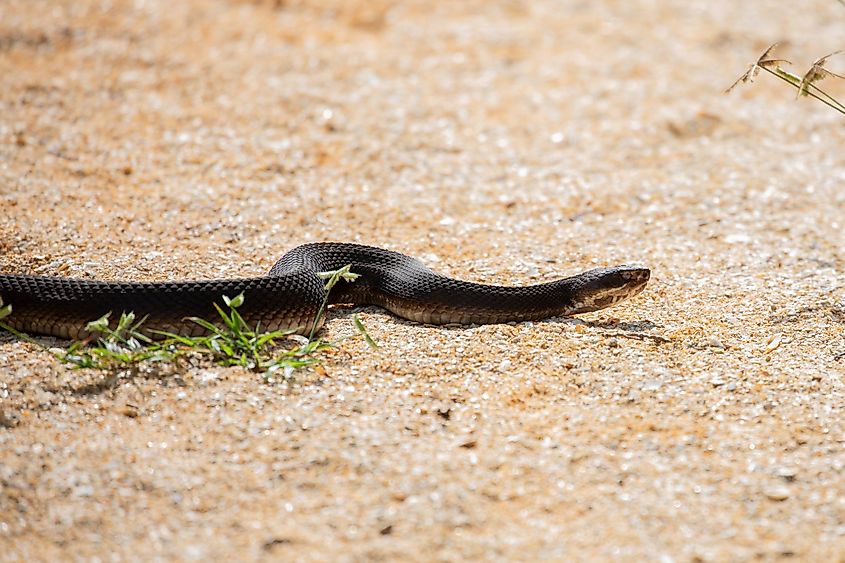
The northern cottonmouth (Agkistrodon piscivorus) is a venomous snake in Arkansas. It can be found across the state in wetland habitats, swamps, Xbox lakes, sloughs, drainage ditches, and streams. It is uncommon in the Ozark Highlands and the Ouachita Mountains.
The northern cottonmouth is a pit viper with a keeled scale, a dark olive-brown to black heavy body, and indistinguishable dark crossbands with a white upper lip and black stripe that stretches from its snout to neck. When a northern cottonmouth feels threatened it will open its mouth to reveal a white lining known as the “cotton mouth”.
Texas Coral Snakes
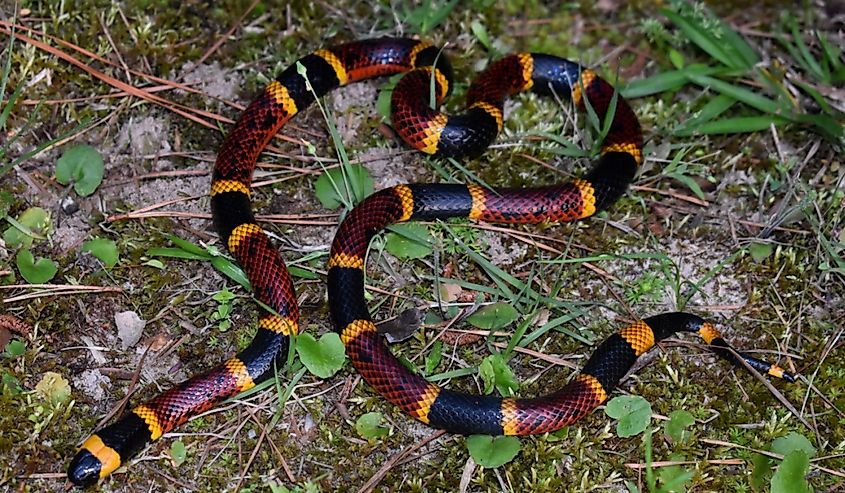
The Texas coral snake (Micurus tener tener) is a tri-colored, medium-sized snake. This venomous snake is present in the southern part of Arkansas, west of the Ouachita River and south of the Little Missouri River. Coral snakes are known for their red, yellow, and black bands circling their bodies. Coral snakes live in forested or dry, sandy environments, opting to hide among organic leaf litter, old stumps, or decayed logs. Texas coral snakes carry a potent neurotoxic venom that is one of the most lethally potent venoms found in a North American snake. These snakes are typically docile but should be treated carefully or avoided entirely.
Snakes, including the northern cottonmouth, prefer to escape their provoker and use camouflage to avoid detection against prey, including humans. Otherwise, these venomous snakes do not purposefully cause harm to humans. Many snakebites happen when a snake feels threatened or harassed. Deaths from snake bites in the US are uncommon.
Be mindful while exploring the Arkansas wilderness to avoid snake encounters. This means watching where you are stepping and placing your hands (or feet) into spaces you cannot see. Boots, hiking shoes, and long pants that protect one’s ankles are other good measures to protect oneself. If you see a snake in the wild, avoid agitating or aggravating it in any way, leave it alone, and keep your distance.
Mosquitos

Mosquitos belonging to the Culicidae family are thin, long-legged, and two-, scale-winged insects. There are over 3,700 mosquito species found worldwide and over 200 species exist in the US. A mosquito’s habitat is variable and can be found within rain puddles or thriving in decomposing leaf litter. All mosquitoes go through a four-stage life cycle, starting as an egg, larva, and pupa in water before maturing into adulthood.
Do not be fooled by the mosquitos' small size! Mosquitos are vectors that can spread rare illnesses like the West Nile or Zika viruses, making them one of the deadliest animals in Arkansas. Other mosquito-borne illnesses like St. Louis encephalitis and Eastern Equine encephalitis may cause flu-like illnesses in people and can also impact birds and other animals.
The best way to avoid contracting mosquito-borne diseases is to prevent bites. Avoid going out at dusk, dawn, or in the early evening, which are peak times for mosquito activity. Wear long sleeves, long pants, and socks if weather permits while venturing outdoors. Consider using an insect repellent registered with the Environmental Protection Agency, which typically has active ingredients like DEET, picaridin, or oil of lemon eucalyptus. Insect repellent should be applied on exposed skin or clothing but should not be applied near the mouth or eyes.
American Alligators
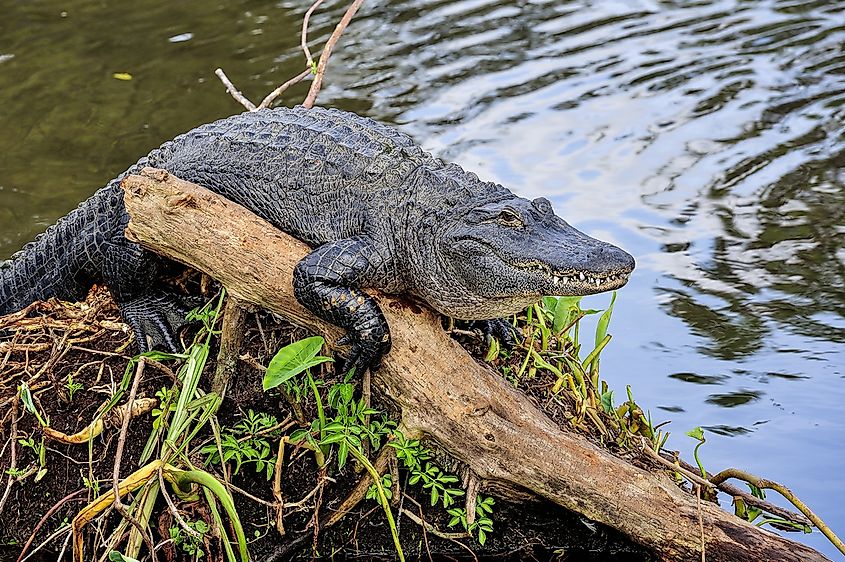
The American alligator (Alligator mississippiensis) is a large crocodilian species often mistaken for the American crocodile (which does not live in the state). These crocodilian species have a bulbous snout and sport a large tail with pointed ridges. It is endemic in the southeastern coastal plain of the US and usually lives in freshwater wetlands and cypress swamps. These reptiles have also been spotted in estuaries with brackish waters. Alligators are present in the Gulf Coastal Plain and the southwestern area of Arkansas. American alligators were an integral part of Arkansas’ native flora for millennia, with its population varying through the decades due to habitat loss, unregulated hunting, federal protection, and restocking initiatives. Since 1984, the population of alligators in Arkansas has increased to stable numbers.
To some, the American alligator may be considered a dangerous animal in Arkansas because of its sheer bite force. In the US, fatal alligator attacks on humans happen but are rare. An American alligator bite also carries a risk of bacterial infection. Otherwise, alligators prefer avoiding people but can pose a safety risk if they are comfortable around humans.
Maintain a safe distance of at least 60 feet from an alligator, whether it is from land or water. Over short distances, alligators are impressively fast and can run 30 mph! While examining an alligator from afar, stand tall, even when taking a photo—alligators judge a prey by its size, and kneeling may make you more of an enticing target than when you are standing. Never feed alligators as it can pose a safety risk.
Ticks
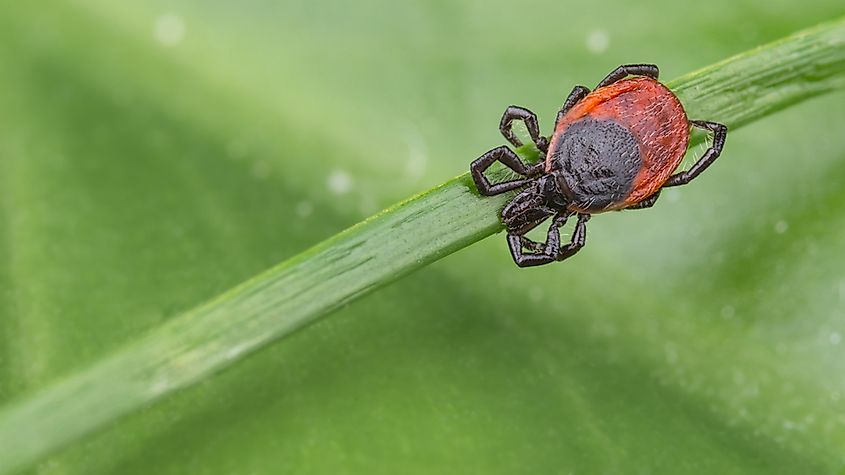
Ticks are part of the arachnid class of arthropods characterized by a head (or capitulum) and an oval-shaped body known as the idiosoma. There are about 900 tick species found worldwide and 90 of them exist in the US. There are several species found in Arkansas, and among them are the American dog (Dermacentor variabilis), black-legged (Ixodes scapularis), Gulf Coast, brown dog (Rhipicephalus sanguineus), or lone star ticks (Amblyomma americanum). A tick’s habitat may vary depending on the species, but all generally thrive in highly humid environments with high grass, brush, or woody areas.
Despite their size, some regard ticks as dangerous in Arkansas because some tick species carry tickborne illnesses like rocky mountain spotted fever, Lyme disease, southern tick associate rash illness, or alpha-gal. Tickborne illnesses may cause symptoms like fever, chills, headaches, muscle aches, fatigue, joint pain, or a rash. In Arkansas, rocky mountain spotted fever is the most common tick-borne disease commonly transmitted by American dog and rocky mountain wood ticks.
Reduce your (and your pet’s) exposure to ticks and tick bites by avoiding tall grasses and sticking to trails during hikes or visits to the park. Wear light-colored, protective clothing when exploring the outdoors, including boots that cover your calves, long pants tucked into your boots, and long-sleeved shirts to discourage ticks from attaching to your skin and crawling up your body. Applying insect repellent containing permethrin to your gear and clothing can also help repel ticks. If a tick attaches to your skin, remove it immediately to prevent the spread of disease.
American Black Bears
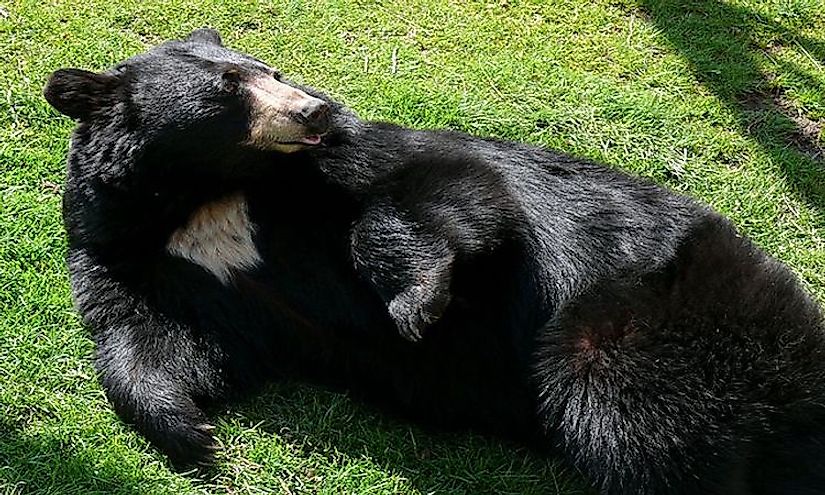
The mighty American black bear (Ursus americanus) is the only bear species that lives in Arkansas. These bears have a rich history in Arkansas, are seen as a valuable resource in colonial times, and star in literary works and local folklore. Its name does not refer to its color but to an actual species! The coats of black bears range in color from cinnamon to brown. At one point, Arkansas was nicknamed the “Bear State” due to its abundant population during pre-settlement times, estimated to be up to 50,000. Unfortunately, by the 1930s, the black bear’s population was severely impacted by hunting, with numbers recovering between 1958 and 1968 thanks to the Black Bear Restoration Program. In Arkansas, black bear habitats can be found in oak-hickory forests of the Interior Highlands and among bottomland hardwood forests of the Delta and Mississippi Alluvial Floodplains.
Although humans and black bears have coexisted for centuries, black bears tend to be shy and elusive. They usually avoid direct contact with humans. Reports of black bear attacks exist, but they are relatively uncommon. Most attacks on people have involved bears that were hand-fed, approached by humans, or were in poor health due to illness or old age.
Although black bears tend to avoid humans, they should still be regarded as dangerous animals in Arkansas. When exploring Arkansas wildlife, look for signs of bears such as tracks, claws, droppings, or claw and bite marks on trees. Observe bears from a safe distance and stay at least 100 yards away. Hikers can whistle, talk, or sing to alert bears of their presence and should keep pets at home for safety. While camping, keep your campsite clean, store food outside your tent, and use air-tight or bear-proof containers, or hang food 15 feet above the ground on a tree. Cook food away from your sleeping area, change clothes after cooking, and wash dishes thoroughly to remove food residues. Bear spray is an effective way to prevent close encounters with black bears.
Arkansas's varied topography and mild climate create a unique range of wildlife. Many animals live in the Natural State, including some of the supposedly deadliest animals in Arkansas, which can pose risks to people. Luckily, many of these dangerous animals are shy and often avoid human contact. People exploring Arkansas outdoors should still practice good wildlife etiquette, whether they are admiring the dangerous animal from a distance or resisting the urge to feed them.











